Crape myrtles are often called the “lilacs of the South” admired for their long summer blooms, peeling bark, and graceful branching. But if you’ve ever wondered when and where to plant them, timing and location are everything.
Plant too early, and frost can damage the roots; plant too late, and heat stress can stunt growth.
So, when’s the best time to plant a crape myrtle?
In most regions, early spring or early fall, when the soil is warm and moisture is consistent ideal.
Still, the perfect time depends on your climate zone and specific conditions.
In this guide, you’ll learn when and where to plant a crape myrtle based on your USDA zone, how to match your planting time and location to your local environment so your crape myrtle thrives for decades.
Table of Contents
Why Timing and Location Matter
Crape myrtles are tough, but they’re also sensitive during their first year. The right timing allows roots to establish before facing stress from heat or frost. Likewise, choosing a sunny, well-drained spot sets the stage for vibrant blooms and smooth, sculptural trunks later on.
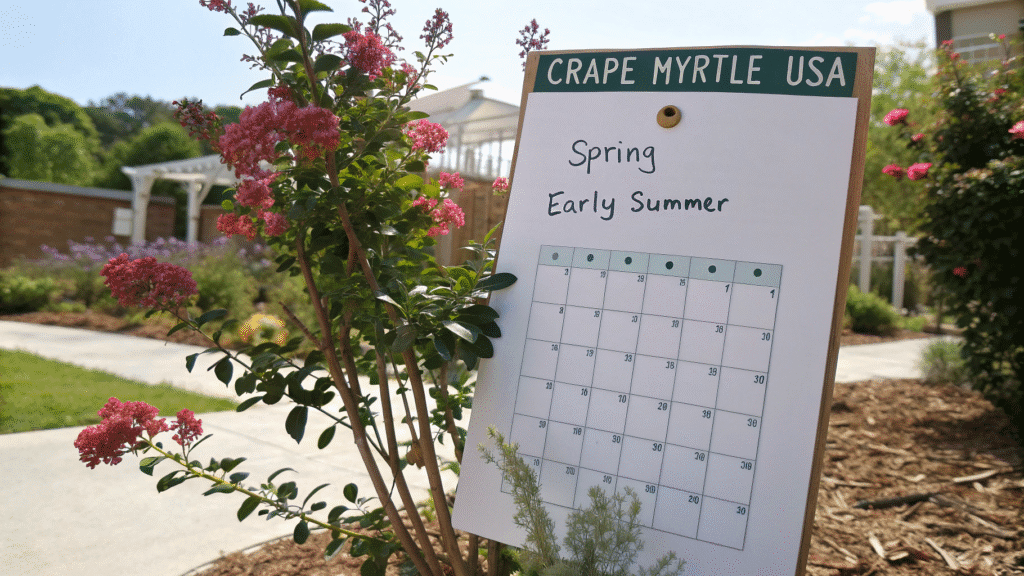
Think of planting as setting the foundation for your tree’s lifetime performance. You’re not just picking a date, you’re creating the conditions for success.
Understanding USDA Zones: Where Crape Myrtles Thrive
The USDA Hardiness Zone Map divides North America into zones based on average winter lows. Crape myrtles are generally hardy in Zones 6 through 10, though a few newer varieties can survive in Zone 5 with protection.
| Zone | Temperature Range (°F) | Crape Myrtle Suitability | Notes |
| 5 | -20 to -10 | Marginal | Only cold-hardy varieties like ‘Tonto’ or ‘Acoma’ may survive; provide heavy mulch. |
| 6 | -10 to 0 | Moderate | Choose smaller or dwarf varieties; protect roots in winter. |
| 7 | 0 to 10 | Excellent | Ideal for most types; some protection recommended in severe cold. |
| 8–9 | 10 to 30 | Perfect | Long bloom season, minimal maintenance. |
| 10 | 30 to 40 | Very good | May bloom year-round; watch for mildew in humid climates. |
If you’re unsure which zone you’re in, you can check the USDA’s online zone map by entering your ZIP code. Once you know your zone, you can align your planting schedule and select the right variety for your region.
When and Where to Plant a Crape Myrtle by Region
Your local climate dictates the perfect planting window. The goal is to give your crape myrtle’s roots time to establish themselves without the stress of extreme heat or cold.
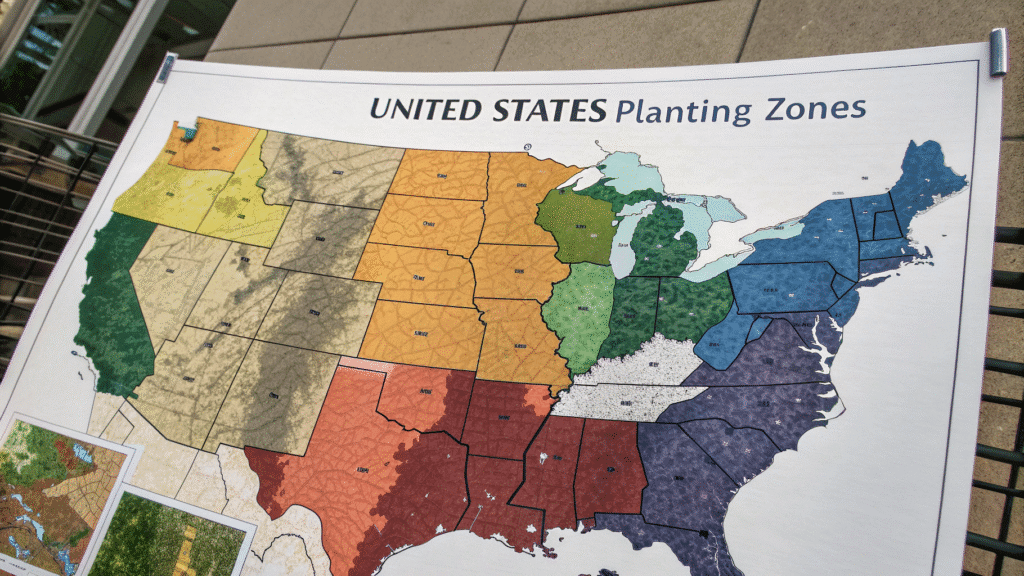
East Coast (Zones 6-7)
From Virginia down through Florida, spring and early fall are your sweet spots.
- Mid-Atlantic (Zones 6-7): Aim for April to May, after the danger of frost has passed. The soil is warming up, and conditions are ideal for root development.
- Southeast (Zones 8-9): March through October works, but avoid planting in the height of summer when temperatures soar above 90°F.
- Avoid: Planting too early in spring when the ground is still cold and soggy, or too late in fall when a sudden frost could damage tender new roots.
Southern States (Zones 7-9): Gulf Coast, Deep South
The South is the crape myrtle’s natural home. In areas like Georgia, Alabama, and Texas, planting can be done almost year-round.
- Best time: February to April, when the soil is still warm but rainfall is steady. Planting in late winter to early spring allows the roots to grow deep into the warm, moist soil long before the brutal summer heat arrives. From September to October is also an excellent, underrated window here, as the soil remains warm.
- Avoid: July and August, as the intense heat can stress a newly planted tree.
Midwest & Lower Northeast (Zone 6)
In states like Missouri, Kansas, and southern Illinois, crape myrtles can grow, but frost sensitivity makes timing crucial.
- Best time: May is your month. The soil must be thoroughly warm, and the chance of frost is minimal. Fall planting is risky here unless done by early September, giving the tree at least 6-8 weeks before the first hard freeze.
- Avoid: Any temptation to plant in autumn after September 15th, as the roots won’t have time to anchor themselves.
TIP: Mulch heavily and choose cold-hardy varieties like ‘Catawba’ or ‘Sioux.’
The West & Southwest (Zones 7-9)
From Southern California to the Pacific Northwest, conditions vary widely.
- Southern California (Zones 9-10): You can plant almost any time of year, avoiding extreme heat spells.
- Northern California and Oregon (Zones 7-8): Late spring or early fall gives the best balance of moisture and temperature.
- Avoid: Planting right before the dry, hot summer season without a reliable irrigation plan. In hot, dry climates like Arizona or New Mexico, summer planting it’s too stressful for young roots.
Choosing the Perfect Planting Spot
Even if you plant at the right time, location can make or break your crape myrtle’s success.
Sunlight Requirements
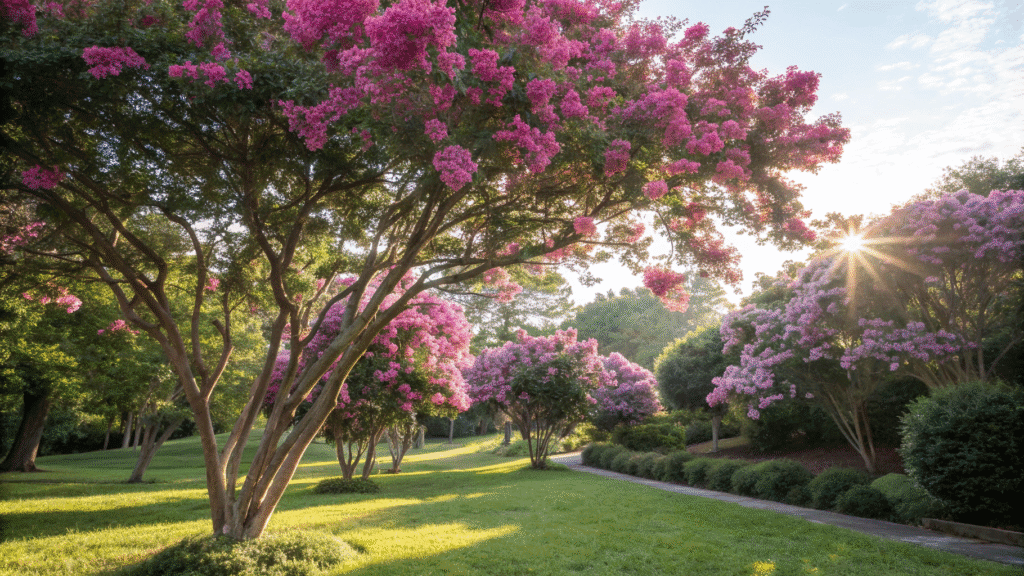
Crape myrtles are sun-lovers. They need at least 6-8 or more hours of direct sunlight per day for strong blooms and vibrant color. In partial shade, you’ll get more leaves than flowers.
If you live in a hot southern region, morning sun with light afternoon shade can help prevent leaf scorch.
Soil Drainage Considerations
Poor drainage is one of the few things crape myrtles won’t tolerate. They prefer well-drained, slightly acidic soil (pH 5.0–6.5).
To test drainage:
- Dig a small hole about a foot deep.
- Fill it with water.
- If it takes more than 3–4 hours to drain, amend with sand, compost, or organic matter.
A great practice is to plant in a raised mound or berm, mixing the native soil with generous amounts of compost or pine bark to improve drainage and aeration.
Avoid low-lying spots where water pools after rain.
Spacing from Foundations and Walkways
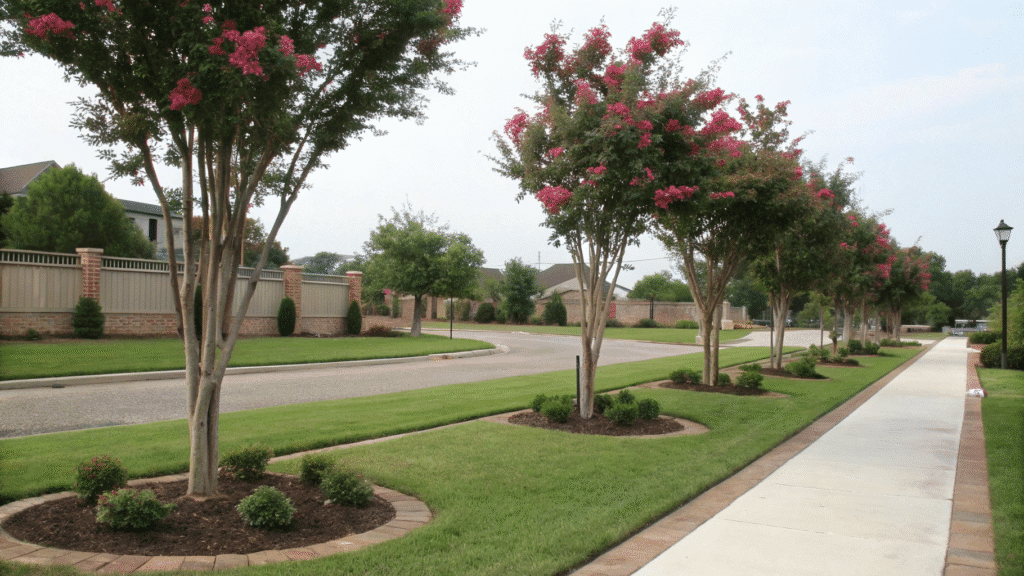
Crape myrtles vary in size, from 3-foot shrubs to 25-foot trees, so space accordingly. Research your variety’s mature width and plant accordingly.
- Dwarf varieties: 3–6 feet from walls or fences.
- Medium varieties: 8–10 feet.
- Large varieties: 12–20 feet or more.
Give roots room to spread and branches space to show off their natural form. Keep them at least 8-10 feet away from your house’s foundation, because roots can lift pavement over time.
Tips for Delayed Planting
Sometimes life or the weather doesn’t cooperate. If you missed the ideal planting window, you can still succeed with a few adjustments.
Planting in Late Spring
When temperatures rise quickly, soil moisture becomes critical.
- Water deeply twice a week rather than frequently shallow watering.
- Add 2–3 inches of mulch (like pine bark or wood chips) around the base to retain moisture, suppress weeds, and regulate soil temperature. Just be sure to pull the mulch a few inches away from the trunk itself to prevent rot.
- Avoid fertilizing right away; wait until new growth appears.
Planting in Early Fall
Fall planting gives roots time to establish before winter.
- Water well until the first frost.
- After planting, apply a thick layer of mulch (4–6 inches) to insulate roots.
- In colder zones (6 and below), wrap the base with burlap or frost cloth during extreme cold.
Caring During Heat or Cold
- Hot Weather: Provide afternoon shade. Water deeply 2-3 times per week for the first few months, allowing the water to penetrate the root ball. A soaker hose is perfect for this. Avoid pruning, which stresses the plant further.
- Cold Weather: If frost is expected soon after planting, cover the young plant with a breathable frost blanket overnight. If a hard freeze is forecast, you can loosely wrap the trunk with burlap or use a tree guard for extra protection, especially in Zones 6.
Example Planting Calendars by Region
Here’s a simplified planting calendar you can use as a quick reference:
| Region | Best Planting Months | Notes |
| Northeast (Zones 6–7) | April–May | Wait until after last frost; mulch heavily. |
| Southeast (Zones 8–9) | March–October | Avoid peak summer heat if possible. |
| Midwest (Zones 5–6) | Late April–June | Choose cold-hardy varieties; protect in winter. |
| South (Zones 7–9) | February–April, Sept–Nov | Excellent growth; water well in dry months. |
| Southwest (Zones 8–10) | Oct–March | Avoid summer planting; use drip irrigation. |
| West Coast (Zones 7–10) | March–May, Sept–Oct | Consistent watering during dry spells. |
Conclusion
You’re now armed with the knowledge to make the perfect decision for your crape myrtle. Planting a crape myrtle isn’t complicated, but it does reward attention to timing and location.
- In Zones 7–9, spring or fall planting gives the best results.
- In colder climates, wait until frost danger passes and protect roots in winter.
- Always choose a sunny, well-drained spot and give your tree enough space to breathe.
But your journey doesn’t end with putting the tree in the ground. The next steps are just as important. Knowing how to water, when and how to prune (a topic with many myths!), and what to feed your tree will take it from simply surviving to absolutely thriving.
With these steps, you’ll set your crape myrtle up for long-lasting beauty, year after year of colorful blooms and elegant bark.

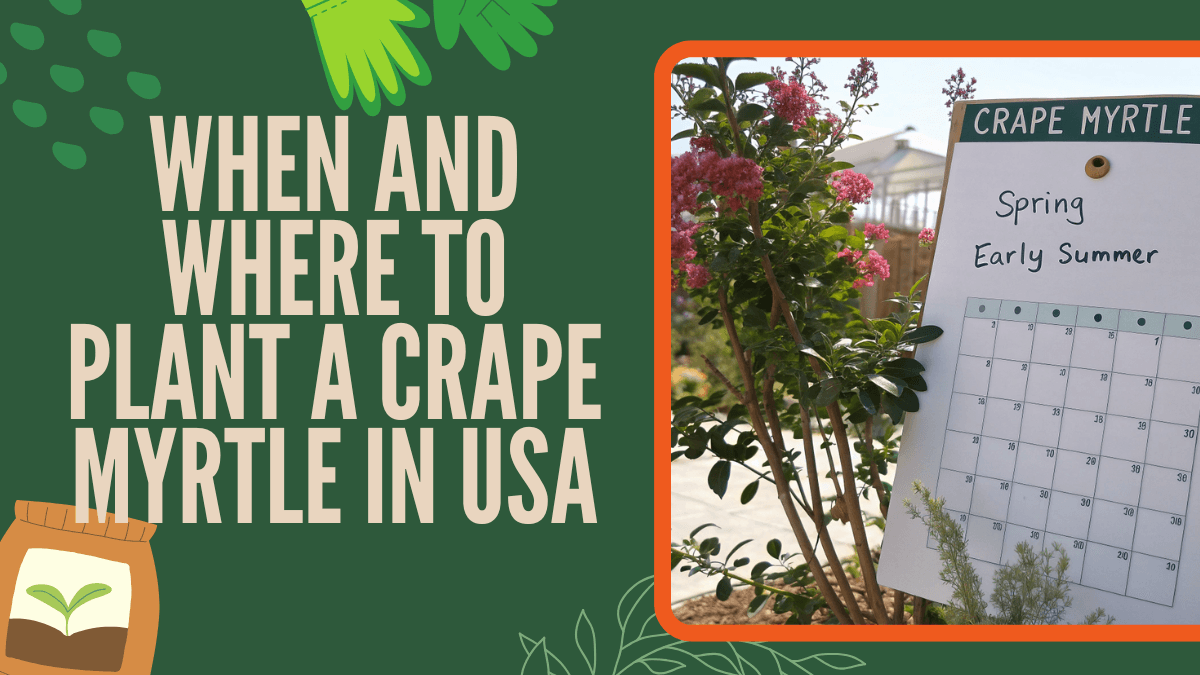
 ChatGPT
ChatGPT
 Perplexity
Perplexity
 Claude
Claude
Leave a Reply